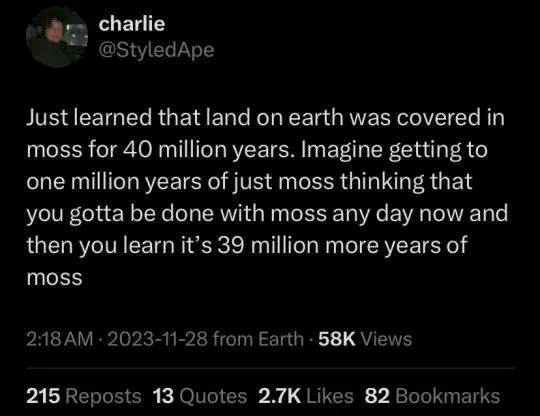this post was submitted on 02 Sep 2024
900 points (99.1% liked)
Science Memes
14207 readers
2450 users here now
Welcome to c/science_memes @ Mander.xyz!
A place for majestic STEMLORD peacocking, as well as memes about the realities of working in a lab.

Rules
- Don't throw mud. Behave like an intellectual and remember the human.
- Keep it rooted (on topic).
- No spam.
- Infographics welcome, get schooled.
This is a science community. We use the Dawkins definition of meme.
Research Committee
Other Mander Communities
Science and Research
Biology and Life Sciences
- !abiogenesis@mander.xyz
- !animal-behavior@mander.xyz
- !anthropology@mander.xyz
- !arachnology@mander.xyz
- !balconygardening@slrpnk.net
- !biodiversity@mander.xyz
- !biology@mander.xyz
- !biophysics@mander.xyz
- !botany@mander.xyz
- !ecology@mander.xyz
- !entomology@mander.xyz
- !fermentation@mander.xyz
- !herpetology@mander.xyz
- !houseplants@mander.xyz
- !medicine@mander.xyz
- !microscopy@mander.xyz
- !mycology@mander.xyz
- !nudibranchs@mander.xyz
- !nutrition@mander.xyz
- !palaeoecology@mander.xyz
- !palaeontology@mander.xyz
- !photosynthesis@mander.xyz
- !plantid@mander.xyz
- !plants@mander.xyz
- !reptiles and amphibians@mander.xyz
Physical Sciences
- !astronomy@mander.xyz
- !chemistry@mander.xyz
- !earthscience@mander.xyz
- !geography@mander.xyz
- !geospatial@mander.xyz
- !nuclear@mander.xyz
- !physics@mander.xyz
- !quantum-computing@mander.xyz
- !spectroscopy@mander.xyz
Humanities and Social Sciences
Practical and Applied Sciences
- !exercise-and sports-science@mander.xyz
- !gardening@mander.xyz
- !self sufficiency@mander.xyz
- !soilscience@slrpnk.net
- !terrariums@mander.xyz
- !timelapse@mander.xyz
Memes
Miscellaneous
founded 2 years ago
MODERATORS
you are viewing a single comment's thread
view the rest of the comments
view the rest of the comments

What was it like? Genuinely curious!
Here are some modern-day variants of mosses that don't even look like what we typically think of as "moss".
Woah, do you have any other interesting info on early earth?
Nowadays, trees absorb CO2 and produce oxygen, and when they die and rot the opposite happens, releasing the CO2 back into the atmosphere.
However, during the carboniferous period, when plants first developed the ability to produce lignin (i.e. wood, essentially) there was not yet any bacteria or fungus that could break this material down. The result is that when trees died they would kinda just lay there. For 50 million years, trees absorbed CO2 and then toppled over and piled on the ground and in water. Most of the world was swamp and rainforest. Millions of years of plant growth all dying and laying on top of each other
So much CO2 was turned into oxygen that O2 levels were 15% higher compared to today. This allowed some truly large lifeforms to develop: trees 150 feet tall, dragonflies with wings 13 inches long, millipedes the size of a car.
The trapping of so much CO2 led to a reverse greenhouse effect, cooling the planet, and eventually an ice age. The forest systems collapsed from the climate change (we think) killing about 10% of all life on earth. Eventually a species of fungus developed the ability to eat lignin, and cleaned up the dead trees that remained on the surface within a few generations. The millions of years of tree material that sank into the bogs eventually turned into coal.
Now we're digging all that good stuff back up and are burning it, yay!
Didn't they just lay around until there was a lightning induced forest fire? I mean until the fungus arrived.
Nice writeup BTW!
Sort of, yeah. Plant matter with lignins still partially decayed into peat. So it's not exactly 50 million years of dead trees on top of each other. It's more like layers and layers of peat, with still "fresh" trees at the top.
that's so cool I love reading about that.
A couple of good books on the subject:
How the Earth Turned Green (most relevant)
Otherlands: A Journey Through Earth's Extinct Worlds